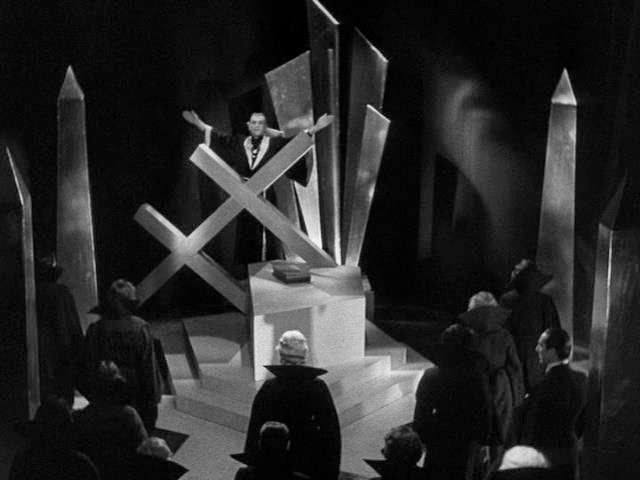(1934) Directed by: Edgar G. Ulmer; Written by: Peter Ruric;
Based on a story by Edgar Allan Poe; Starring: Boris Karloff, Bela Lugosi,
David Manners, Julie Bishop and Lucille Lund; Available on DVD.
Rating: ****
“Supernatural, perhaps. Baloney, perhaps not. There are many
things under the sun.”
– Dr. Vitus Werdegast (Bela Lugosi)
“…You say your soul was killed, that you have been dead all
these years. And what of me? Did we not both die here in Marmaros 15 years ago?
Are we any the less victims of the war than those whose bodies were torn
asunder? Are we not both the living dead?”
– Hjalmar Poelzig (Boris Karloff)
The Black Cat
might just be the ideal vehicle to showcase the talents of on and off-screen
rivals Boris Karloff and Bela Lugosi. While the reality of their rivalry is
probably less interesting than the publicized version, a kernel of truth lies
within. Lugosi burst out of the gates with Universal Studios’ first bonafide
talkie horror hit Dracula, but was quickly overtaken by Karloff in Frankenstein (in a role that Lugosi famously turned down) and other
subsequent films. The fact that Karloff was frequently offered juicier roles,
while Lugosi was often relegated to second banana characters only helped stoke
the flames of (alleged) animosity between the two. What makes The Black Cat
such a pleasure to watch is that both actors are at the top of their form, and
were given equal time.* Director Edgar G. Ulmer (a German transplant who worked
under F.W. Murnau) and writer Peter Ruric spin a deliciously macabre tale of
revenge, based (very) loosely on an Edgar Allan Poe story.
* According to Arthur Lenning in The Immortal Count: The Life and Times of Bela Lugosi, Karloff was
compensated a flat rate of $7,500 for his work in The Black Cat, while Lugosi received $1,000 a week for three works
(compare to David Manners’ salary of $1,200 a week for a supporting role).
Karloff is striking as satanic architect Hjalmar Poelzig.
With his pallid complexion, angular facial features and dead stare, he
resembles a walking corpse rather than a living man. Although we’re commonly taught
you can’t judge a book by its cover, his appearance mirrors his evil deeds.
Poelzig’s erudite demeanor belies his sinister intent. He’s a man who has experienced
so much death in his lifetime that he has become death.
In a scene that will likely appear cliché to modern
audiences, he sits at his organ, playing Bach’s “Toccata & Fugue in D
Minor” (It must be an unwritten rule that all villains learn this familiar
musical piece).
Lugosi displays tremendous range as the haunted psychiatrist
Dr. Vitus Werdegast. For reasons not made entirely clear, his nemesis Poelzig
has profited from war and destruction, while Werdegast has spent the past 15
years wasting away in prison. En route to his confrontation with the man who
ruined his life, Werdegast encounters an American newlywed couple (David
Manners and Jacqueline Wells as Peter and Joan Alison) on a train to Budapest. After
their tour bus crashes, they accompany him to Poelzig’s home, where a match of
wits is about to begin. When it becomes apparent that Poelzig wishes to keep Joan
for himself, Werdegast remarks, “There was nothing spiritual in your eyes.” The
two enemies engage in an all-stakes chess game for the woman’s fate, while the
ineffectual Peter stands on the sidelines. According to Arthur Lenning, the
filmmakers toned down Werdegast to make his actions seem more heroic in
contrast to Poelzig’s treachery. Embittered
by years of incarceration, Werdegast has suffered many losses, but not all of his
humanity. He intends to prevent Joan from becoming another conquest. Along with
his manservant Thamal (Harry Cording) he bides his time, waiting for the
opportunity to strike. By the time Werdegast exacts his gruesome revenge against
Poelzig, our eyes, but not our ears are spared.
A moribund atmosphere surrounds everyone and everything in
the film. Werdegast describes Poelzig’s domicile as a “masterpiece of
construction, built upon the ruins of a masterpiece of destruction.” The
modernist house, replete with sliding doors, a sweeping staircase and rectangular
features was designed by Poelzig and built atop the ruins of a fort, while the structure’s
sharp angles echo its creator’s geometric appearance. Underneath the house, at
the former entrance to the gun turrets, lies a dungeon with “death in the air.”
Locked away in the bowels of the dungeon, the preserved corpse of Werdegast’s
wife, one of Poelzig’s former conquests, is kept on display. Poelzig
subsequently married the daughter, Karen (Lucille Lund), who remains unaware
that her father still lives.
The Black Cat’s pervasive
sense of gloom is marred only by a few abrupt tonal shifts. The opening and
closing scenes with the newlyweds seem more appropriate for a light romantic
comedy than a morose tale about a Satan worshipper. Similarly, an awkward comic
sequence ensues when policemen come knocking at Poelzig’s door. Arguably, all
of the ancillary characters in this film are extraneous, since our eyes remain
glued to the screen whenever Karloff and Lugosi appear. The Black Cat suitably exploits the respective charms of both actors,
and features one of Lugosi’s finest performances.







No comments:
Post a Comment